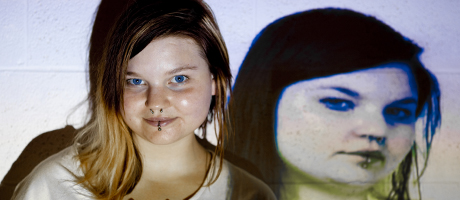By Julia Parmley
Hot dogs, pizza and macaroni and cheese were staples in the Baltimore row house of Chanan Delivuk, M.F.A.’10, and her extended family while she grew up. But now, the only interaction the GW alumna has with meat is through her art.
A vegan and self-described “conversation artist,” Ms. Delivuk uses food as both an instrument and a topic of conversation in her work. She attributes her interest in the subject to her decision to become vegan at 18.
“As I got older and started to educate myself and think more consciously about the environment, animals and my health, I became vegan,” says Ms. Delivuk. “It’s been a big educational process to figure out what to eat, as you’re constantly looking at labels to know what is in products. Food is a universal topic that is always talked about.”
And talk about food is the basis of Ms. Delivuk’s multimedia thesis exhibition “…what do you say?” For her project, Ms. Delivuk interviewed seven people working or involved in the food industry, including a butcher from Wagshals, a soybean farmer in Illinois and a lobbyist for The Fertilizer Institute, and recorded and transcribed the interviews. She then taped herself lip synching each interview, role playing as her subjects.
During her exhibit in GW’s Smith Hall of Art, Ms. Delivuk played the video of her lip synching from three projection screens around the gallery and offered transcripts of the interviews for people to read along. Ms. Delivuk also had a wall-sized diagram of food names with soy crayons for visitors to add ideas, and replicated her personal studio in the exhibit to show visitors her workspace.
Ms. Delivuk says she decided to lip synch the interviews to change up the usual “one-on-one” interview. “By using myself, the interview becomes an overarching self portrait,” she says. “I am becoming these people, people who have different viewpoints but in the end, are me,” she says. “So even though my subjects disagree completely, they appear to be the same.”
Ms. Delivuk’s interest in art came by trial and error. As an undergraduate in McDaniel College in Westminster, Md., Ms. Delivuk began pursuing a journalism major. But it was when she enrolled in an art class her sophomore year that she realized she had to pursue the field “for something challenging and new.”
Ms. Delivuk came to GW’s studio art program in 2008 with a portfolio of “pro-vegan, activism” art, including an installation of 269 newspaper-plastered chickens, which represented how many chickens are killed every second, and plastered “body parts” she had wrapped at a family meat shop of a fellow classmate and priced as normal meat, which she then photographed in grocery stores. At GW, Ms. Delivuk quickly incorporated technology into her projects, including creating stop-motion animations using meat.
“When I came to GW, I wanted to broaden my audience,” she says. “My old work wasn’t as successful because people didn’t want to be preached to, but if you’re educating them in a certain way, that’s more inviting. My current work is still about me as a vegan but it’s more open to other viewpoints.”
Ms. Delivuk, who just received her master’s last month, will spend the summer preparing for a solo exhibit at McDaniel College and for her position teaching drawing at GW this fall. She says she still wants to stay connected to the university’s studio arts program and credits the new media courses with enhancing her work.
“New media is becoming more mainstream in the art world and is something that’s getting more respect,” she says. “The faculty at GW is very knowledgeable about new media so the field is growing here. I don’t think my work would be where it is without new media. I still have a lot to learn, but I think I now have a good understanding of what I’m doing.”


